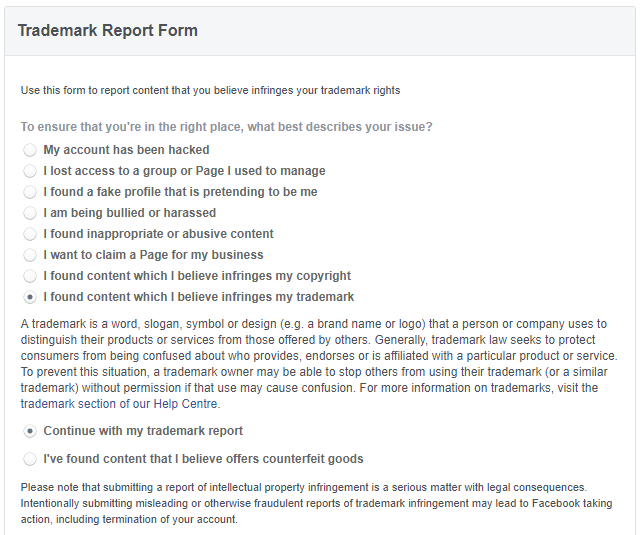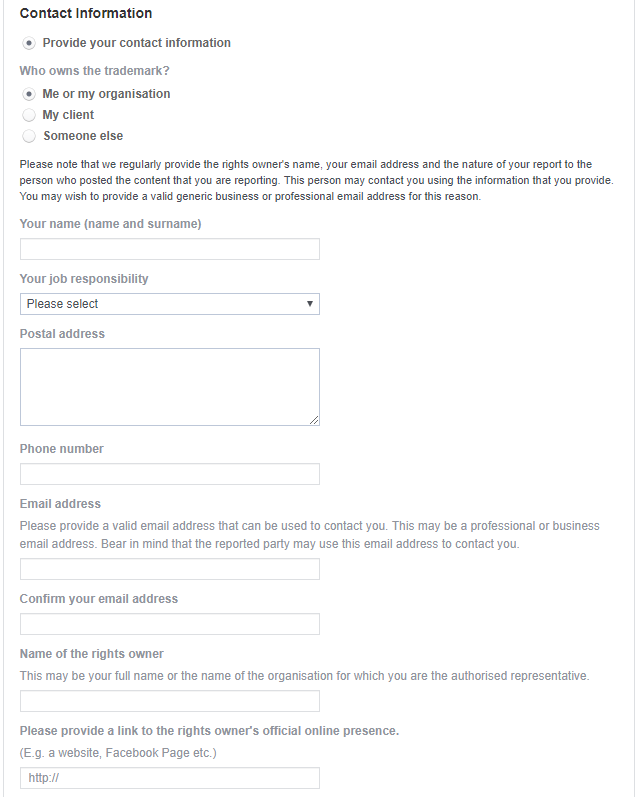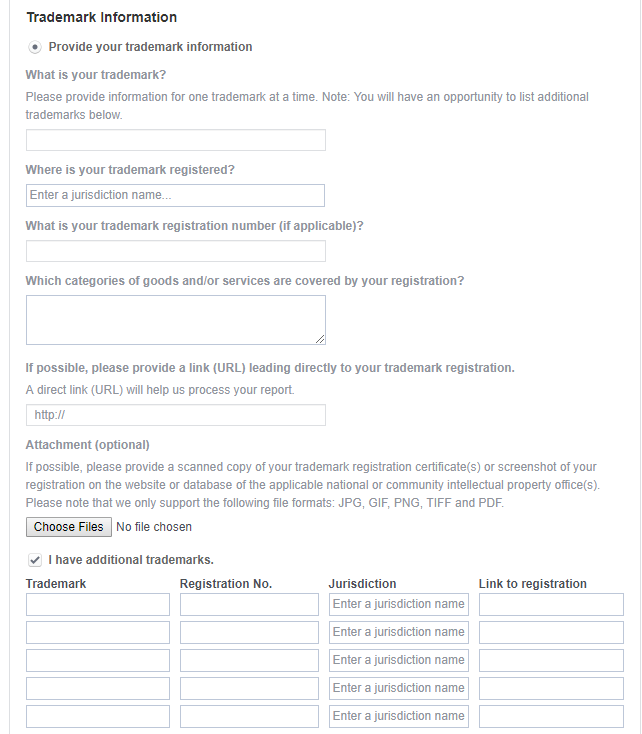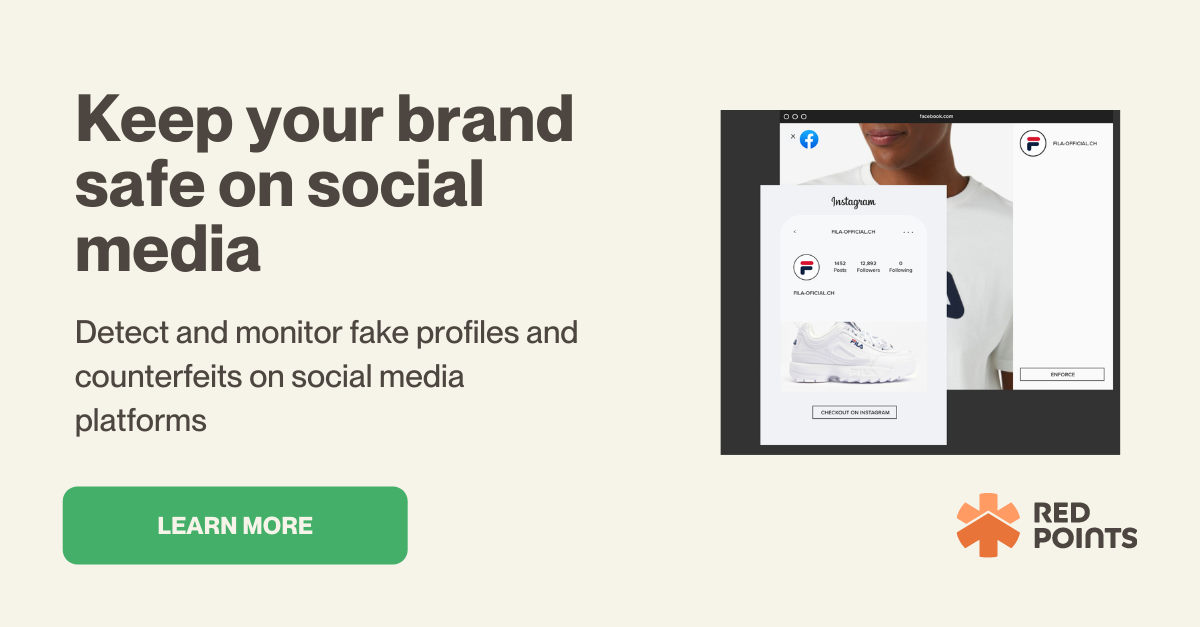
Table of Contents:
Last updated on: July 12, 2023
This article will show you how to find infringement on your product, and how to report a seller on Facebook using various reporting options.
Pursuing claims of copyright infringement on social media platforms is often fraught with confusion and difficulty. While the Copyright Act theoretically provides legal protection and social media companies have policies in place to assist with copyright issues, the reality is that it’s up to rights holders themselves to identify and notify social media platforms of any copyright infringement.
And with millions of profiles, pages, and active groups, finding and reporting instances of counterfeiting is no easy task, so it’s vital for brands to know how to report someone selling counterfeit goods on Facebook.

If you are seeing counterfeit products of your brand being sold on Facebook, this might be a sign that they are being sold on other marketplaces as well. Red Points brand intelligence platform can detect all kinds of infringements being sold online, our technology-empowered bot scans 24/7 on the internet across all online marketplaces.
This section will walk you through the process of reporting instances IP infringement on Facebook. Before we get started with reporting, it’s important to first consider the locations within the platform that sellers might use as an online point of sale for counterfeit goods.
There are several places where counterfeit goods are commonly sold on Facebook:
A Facebook group can be created by anyone. In their Transparency Report, Facebook revealed that private and closed groups are where the vast majority of counterfeit sales occur. Therefore, it is essential to monitor groups relevant to the product in question, as these are where counterfeits are most likely to be sold.
Under four reporting categories (Brand Abuse, Counterfeit, Design, and Patent), Facebook will remove infringing content.
Brand Abuse: Facebook will remove the infringing content.
Counterfeit: This sometimes requires the trademark to be registered in the country where the post was made.
Design: There is no specific form for design infringements, leaving three options:
Patent: Facebook does not remove patent infringement, but we can attempt it anyway via the Counterfeit Form. To do this, we must try to claim as many brands as possible. There is an option to add more trademarks, which gives us an increased likelihood of the content being removed worldwide instead of within a specific jurisdiction. This is usually quick and effective.
To file a report on Facebook, you must be logged into your Facebook account.
To report a seller on Facebook for brand abuse, fill in the Trademark Report Form as seen below, marking the following boxes:

For contact information, check the boxes for:
And then fill in the rest of the contact details as appropriate.

In the next section, trademark information, complete these fields:
Multiple submissions can be made at once by checking the “I have additional trademarks” box.

To report Counterfeit, fill in the Counterfeit Report Form as below:

To report Copyright, fill in the Copyright Report Form by following similar steps to the counterfeit report (images in the above section).
Next, you’ll be asked to provide your contact information, including
The next steps mimic the processes for reporting counterfeit products, as explained above, and relate to:
Reporting and successfully removing design infringements tend to be more difficult on Facebook than on other forms of intellectual property. Though it’s always still worth filing reports.
To report a design infringement, use either the Trademark Form or Counterfeit Form as previously mentioned, and follow the same steps, with a few differences:
Alternatively, for more artistic creations, design infringement can be reported via the Copyright Report Form, alleging that the links are infringing on artwork.
To report Patents, use the Counterfeit Report Form, as below.
Note: As previously mentioned, Facebook does not close patent infringements. Two workaround options are to:
Facebook’s policy regarding locations is as follows:
.png)
However, it is possible to report a location using the trademark form. In the description box, explain in detail that by using the protected trademark and the name of our client or making a clear reference to their distinctive signs, these locations are making the users of the platform believe that they are official or authorized locations of our client’s business. This can be a problem if these locations post confusing or illegitimate content as it may damage our client’s reputation. Furthermore, Facebook users, by following these locations, may think they are reaching our client’s location and go somewhere that has nothing to do with the business.
Once an answer has been received, explain the more specific reasons why these locations are infringing on the business. These could include:
Removal time typically ranges from 1-3 days. Facebook will send a ticket to your email with a complaint number, confirming that the report was made. After processing your request, you will receive an email either confirming the removal or explaining the reasons why they refuse to act.
It is also important to note that when reporting content from a group, the analyst will have requested to join the group in order to upload the link to the portal. To see the content of the group, it is necessary to be logged into the same account that the analyst used to upload the links. Otherwise, we see closed links, as below.

Finding sellers of counterfeit products is becoming increasingly difficult. In its emergence as a powerful social media platform, Facebook simultaneously became a global distribution channel, allowing illegitimate sellers to copy patented products and sell them to others via their social networks.
Despite strict procedures in place to remove offending products from its pages, it is almost impossible—without the intervention of the rightsholder—for Facebook to identify which products are legitimate and which are counterfeit. Despite this, Facebook’s recent biannual Transparency Report revealed that it removed almost 2.8 million pieces of content based on 373,934 copyright reports, 222,226 pieces of content based on 61,172 trademark reports, and 459,176 pieces of content based on 28,680 counterfeit reports in 2018.

The law protects websites from being held responsible for what is sold by third parties on their platforms, acknowledging that it would be almost impossible for companies to monitor every single product that is being offered for sale on their sites.
This is because, as part of the 1998 Digital Millennium Copyright Act, Congress gave “safe harbor” immunity to companies providing online services, effectively protecting them from copyright infringement liability for their users’ actions. Essentially, websites cannot be held responsible for what is sold on their platforms as long as they have a “rigorous” takedown procedure in place to address complaints about counterfeit goods.
With the rise of social media and social selling, that task falls unfortunately on the shoulders of individual rights holders or those acting on their behalf, requiring them to actively police Facebook profiles, pages, and groups for counterfeit products that infringe on their trademarks. Currently, getting these links removed and accounts banned is the only viable strategy. Legal recourse against the sellers is rarely possible as false identities are typically created to participate in these pages and groups.
Much like other social media platforms that experience similar problems with counterfeit and copyright infringement, Facebook’s policies and Terms of Use strictly prohibit the advertisement, promotion, or facilitation of the sale of counterfeit goods.
To combat counterfeit sales, Facebook has a robust manual and automated system in place to review and take action on all reports of copyright infringement and illegal counterfeit products. Despite these measures, it often falls to the copyright holders to owners to bring these infringements to the attention of Facebook analysts. The purpose of this book is to help you do exactly that.
As you can see, detecting and reporting IP infringement on Facebook can be a daunting task. Regardless of the size of your business, the time, expertise, and financial resources required to monitor, detect and report infringements are overwhelming.
At Red Points, our in-house technology allows us to scan online marketplaces and social media platforms for infringements. Our analysts will then compile and send you the results. We provide robust detection technology, the power of a large search team, and the knowledge of an experienced legal department; all available on your desktop 24 hours a day, at a fraction of the time and financial cost, allowing you to do what you do best – run your business!
Having intellectual property issues on other websites? Take a look out our list of counterfeit removal guides:
